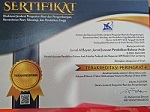Accuracy Analysis of Artificial Intelligence in Arabic Language Translation and Grammatical Rule Mapping
Abstract
Keywords
Full Text:
PDFReferences
Al-Batineh, Mohammed, and Razan Alawneh. “Current Trends in Localizing Video Games into Arabic: Localization Levels and Gamers’ Preferences.” Perspectives 30, no. 2 (2022): 323–342.
Al-Khalafat, Leen, and Ahmad S. Haider. “A Corpus-Assisted Translation Study of Strategies Used in Rendering Culture-Bound Expressions in the Speeches of King Abdullah II.” Theory and Practice in Language Studies 12, no. 1 (2022): 130–142.
Al-Shalabi, Riyad, Ghassan Kanaan, Tarek Kanan, Mohammed ElBes. “A Review Study for Arabic Machine Learning and Deep Learning Methods." 2022 ASU International Conference in Emerging Technologies for Sustainability and Intelligent Systems (ICETSIS) (2022): 225–232.
Al-Thubaity, Abdulmohsen, Sakhar Alkhereyf, Hanan Murayshid, Nouf Alshalawi, Maha Omirah, Raghad Alateeq, Rawabi Almutairi, Razan Alsuwailem, Manal Alhassoun, and Imaan Alkhanen. “Evaluating ChatGPT and Bard AI on Arabic Sentiment Analysis.” Proceedings of ArabicNLP 2023 (2023): 335–349.
Abdelali, Ahmed, Hamdy Mubarak, Shammur Absar Chowdhury, Maram Hasanain, Basel Mousi, Sabri Boughorbel, Samir Abdaljalil, et al. “Larabench: Benchmarking Arabic AI with Large Language Models.” Proceedings of the 18th Conference of the European Chapter of the Association for Computational Linguistics 1 (2024): 487-520.
Ahkas, Akmal Walad, and Al Lu’lu’ Mahabbah Fillah. “Analisis Buku Nahwu Wadhih Juz 2 Karya Ali Al-Jarimi dan Musthafa Amin.” Ta’lim al-’Arabiyyah: Jurnal Pendidikan Bahasa Arab & Kebahasaaraban 6, no. 1 (2022): 125–133
Ait ElFqih, Khadija, and Johanna Monti. “Large Language Models as Legal Translators of Arabic Legislation: Does ChatGPT and Gemini Care for Context and Terminology?” Proceedings of The Second Arabic Natural Language Processing Conference (2024): 111–122.
Alexander, Bryan, Kevin Ashford-Rowe, Noreen Barajas-Murphy, Gregory Dobbin, Jessica Knott, Mark McCormack, Jeffrey Pomerantz, Ryan Seilhamer, and Nicole Weber. “Educause Horizon Report: 2019 Higher Education Edition, 2019.” Retrieved May 8 (2023).
Chassignol, Maud, Aleksandr Khoroshavin, Alexandra Klimova, and Anna Bilyatdinova. “Artificial Intelligence Trends in Education: A Narrative Overview.” Procedia Computer Science 136 (2018): 16–24.
Chen, Lijia, Pingping Chen, and Zhijian Lin. “Artificial Intelligence in Education: A Review.” Ieee Access 8 (2020): 75264–75278.
Diantami, Tri, Siwi Widura Yuwana, and Eni Nurhayati. “Pentingnya Pendidikan Bahasa dalam Membangun Karakter yang Berbudaya di SMP PGRI 9 Sidoarjo.” Jurnal Riset Rumpun Ilmu Bahasa 2, no. 2 (2023): 132–144.
Duan, Yanqing, John S. Edwards, and Yogesh K Dwivedi. “Artificial Intelligence for Decision Making in the Era of Big Data–Evolution, Challenges and Research Agenda.” International Journal of Information Management 48 (2019): 63–71.
Fahraini, Sovia, and Muhammad Fikri Almaliki. “Analysis of Arabic Against the Use of Artificial Intelligence (AI) Through Tashkeel (Automatic Harokat) Application To Increase Maharah Qiraah,” International Conference on Education (2023): 64-77.
Fareed, Mohamed W., Ali Bou Nassif, and Eslam Nofal. “Exploring the Potentials of Artificial Intelligence Image Generators for Educating the History of Architecture.” Heritage 7, no. 3 (2024): 1727–1753.
Faris, Hamzah, and Maman Abdurrahman. “Analisis Penerjemahan Bahasa Arab ke Bahasa Indonesia Melalui Artificial Intelligence ChatGPT.” Al-Af’idah: Jurnal Pendidikan Bahasa Arab dan Pengajarannya 7, no. 2 (2023): 222-233.
Fayyoumi, Khalil A. “Analyzing Active Tasks in Jordanian Primary Arabic Textbooks: Teaching Strategies and Skill Development Implications.” International Journal of Instruction 17, no. 2 (2024): 497–518.
Firmansyah, Muhammad, Masrun Masrun, and I Dewa Ketut Yudha S. “Esensi Perbedaan Metode Kualitatif dan Kuantitatif.” Elastisitas: Jurnal Ekonomi Pembangunan 3, no. 2 (2021): 156–159.
Growiec, Jakub. “Existential Risk from Transformative AI: An Economic Perspective.” Technological and Economic Development of Economy 30, no. 6 (2024): 1682–1708.
Holilulloh, Andi, Mujawir Sayyid Mujawir Sakran, and Wail As-Sayyid. “Analisis Materi dan Metode Sintaksis Arab dalam Kitab An-Nahwu Al-Wadhih.” Al-Fathin: Jurnal Bahasa dan Sastra Arab 3, no. 02 (2020): 125-139.
Hussein, Ahmed, Mohamed Medhat Gaber, Eyad Elyan, and Chrisina Jayne. “Imitation Learning: A Survey of Learning Methods.” ACM Computing Surveys 50, no. 2 (2017): 1–35.
Jarrahi, Mohammad Hossein. “Artificial Intelligence and the Future of Work: Human-AI Symbiosis in Organizational Decision Making.” Business Horizons 61, no. 4 (July 2018): 577–586.
Liu, Jae Q. J., Kelvin T. K. Hui, Fadi Al Zoubi, Zing Z. X. Zhou, Dino Samartzis, Curtis C. H. Yu, Jeremy R. Chang, and Arnold Y. L. Wong. “The Great Detectives: Humans versus AI Detectors in Catching Large Language Model-Generated Medical Writing.” International Journal for Educational Integrity 20, no. 1 (2024): 8.
Maier, Daniel, Christian Baden, Daniela Stoltenberg, Maya De Vries-Kedem, and Annie Waldherr. “Machine Translation Vs. Multilingual Dictionaries Assessing Two Strategies for the Topic Modeling of Multilingual Text Collections.” Communication Methods and Measures 16, no. 1 (2022): 19–38.
Mohammdi, Hosnia M., and Doaa M. Elbourhamy. “An Intelligent System to Help Deaf Students Learn Arabic Sign Language.” Interactive Learning Environments 31, no. 5 (2023): 3195–3210.
Muzdalifah, Zahrotul, Moh. Khasairi, and Kholisin Kholisin. “Development of the Arabic Grammar (Nahwu) Textbook Al-Ajurumiyyah Al-Qur’aniyyah Based on the Scaffolding-Structure.” Izdihar: Journal of Arabic Language Teaching, Linguistics, and Literature 4, no. 2 (2021): 153–164.
Nurjannah Pujirahayu, Rosendah Dwi Maulaya, Devi Nur Suryanita, and Annisa Avilya. “The Adventure of NAQY (Nahwu Qurany) Nahwu Learning Solutions Based on Online Games.” Proceeding of International Conference on Islamic Education (ICIED) (2022): 547-554.
Nurullawasepa, Martiana, Nenden Zakiyah Mandani, Robiah Adawiyah, Sholahuddin Al Ayyubi, and Andi Ahmad Abdillah. “AI (Artificial Intelligence) dalam penerjemahan teks Bahasa Arab.” Senriabdi (2023): 141-157.
Omar, Lamis Ismail, and Abdelrahman Abdalla Salih. “Systematic Review of English/Arabic Machine Translation Postediting: Implications for AI Application in Translation Research and Pedagogy.” Informatics 11, no. 2 (2024): 23.
Rochmat, Cecep Sobar, Riza Riza, and Safitri Anggia Murni. “Artificial Intelligence in Education: Opportunities and Challenges in Improving Learning Efficiency in the Society 5.0 Era.” Progresiva: Jurnal Pemikiran dan Pendidikan Islam 13, no. 01 (2024): 91–100.
Rudolph, Jurgen, Shannon Tan, and Samson Tan. “War of the Chatbots: Bard, Bing Chat, ChatGPT, Ernie and beyond. The New AI Gold Rush and Its Impact on Higher Education.” Journal of Applied Learning & Teaching 6, no. 1 (2023): 364-389.
Salah, Khaled, M. Habib Ur Rehman, Nishara Nizamuddin, and Ala Al-Fuqaha. “Blockchain for AI: Review and Open Research Challenges.” Ieee Access 7 (2019): 10127–10149.
Samuel, Jim, Rajiv Kashyap, Yana Samuel, and Alexander Pelaez. “Adaptive Cognitive Fit: Artificial Intelligence Augmented Management of Information Facets and Representations.” International Journal of Information Management 65 (2022): 102505.
Sarker, Iqbal H. “Machine Learning: Algorithms, Real-World Applications and Research Directions.” SN Computer Science 2, no. 3 (2021): 160.
Synekop, Oksana, Iryna Lytovchenko, Yuliana Lavrysh, and Valentyna Lukianenko. “Use of ChatGPT in English for Engineering Classes: Are Students’ and Teachers’ Views on its Opportunities and Challenges Similar?” International Journal of Interactive Mobile Technologies (iJIM) 18, no. 3 (2024): 129–146
Timms, Michael J. “Letting Artificial Intelligence in Education Out of the Box: Educational Cobots and Smart Classrooms.” International Journal of Artificial Intelligence in Education 26, no. 2 (2016): 701–712.
Tseng, Yu-Ching, and Yi-Hsuan Lin. “Enhancing English as a Foreign Language (EFL) Learners’ Writing with ChatGPT: A University-Level Course Design.” Electronic Journal of E-Learning 22, no. 2 (2024): 78–97.
Utami, Putri Lintang, Nadi Suprapto, Hasan N. Hidaayatullaah, and Tsung-Hui Cheng. “The Comparison of ChatGPT, Perplexity AI, and Scopus Database to Capture Indonesian Higher Education Quality in Achieving SDGs 2030.” E3S Web of Conferences 513 (2024): 1-10.
Xu, Zhenyu, Ruoyu Xu, and Victor S. Sheng. “ChatGPT-Generated Code Assignment Detection Using Perplexity of Large Language Models (Student Abstract).” Proceedings of the AAAI Conference on Artificial Intelligence 38, no. 21 (2024): 23688–23689.
Zaimah, Nely Rahmawati, Eko Budi Hartanto, and Fatchiatu Zahro. “Acceptability and Effectiveness Analysis of Large Language Model-Based Artificial Intelligence Chatbot Among Arabic Learners.” Mantiqu Tayr: Journal of Arabic Language 4, no. 1 (2023): 1–20.
Zhou, Zhi, Xu Chen, En Li, Liekang Zeng, Ke Luo, and Junshan Zhang. “Edge Intelligence: Paving the Last Mile of Artificial Intelligence with Edge Computing.” Proceedings of the Ieee 107, no. 8 (2019): 1738–1762.
DOI: http://dx.doi.org/10.24042/albayan.v16i2.24588
Refbacks
- There are currently no refbacks.
Copyright (c) 2024 Jurnal Al Bayan: Jurnal Jurusan Pendidikan Bahasa Arab
License URL: https://creativecommons.org/licenses/by-nc-sa/4.0
Editorial Office:
Jurnal Al Bayan: Jurnal Jurusan Pendidikan Bahasa Arab, Arabic Education Study Program, Faculty of Education and Teachers Training, Unversitas Islam Negeri Raden Intan Lampung
Jl. Endro Suratmin 1 Sukarame, Bandar Lampung 35131-Indonesia
e-mail: jurnalalbayan@radenintan.ac.id
http://ejournal.radenintan.ac.id/index.php/albayan/index
Jurnal Al Bayan: Jurnal Jurusan Pendidikan Bahasa Arab is licensed under a Creative Commons Attribution-ShareAlike 4.0 International License. p-ISSN 2086-9282 | e-ISSN 2549-1229









